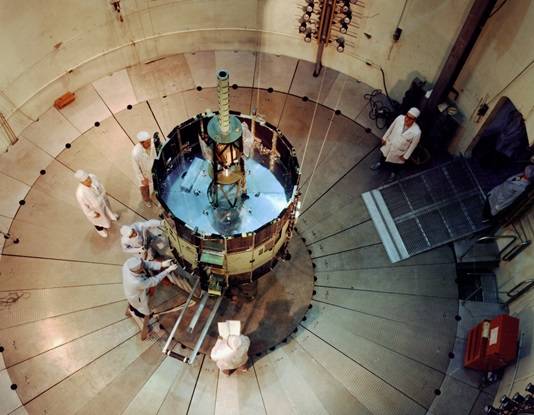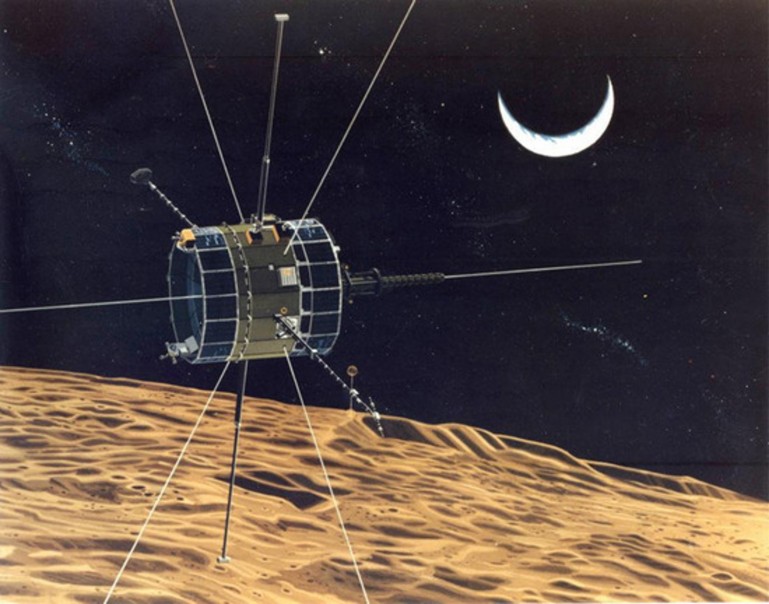ISEE-3. 17 years of sleep
This year began the third life of the station running 36 years ago. Stations with a very difficult fate.
In 1978, both the scientific community and ordinary amateurs tracked the landing of Venus-11, Venera-12 and Pioneer Venus Multiprobe stations on Venus, waited for the Voyager series stations to fly past Jupiter and Pioneer 11 near Saturn, and also admired the new color pictures of Mars that transmitted the orbital and descent module stations of the Viking series. Against this background, the launch of the station for the study of solar-terrestrial relations did not attract much attention.

ISEE-3 in assembly shop
')
ISEE-3 was launched on August 12, 1978, and on October 21 it took its place not far from the Lagrange point. This point, located on the line connecting the centers of the Earth and the Sun, is 1.5 million km from the Earth. By the way, this was the first object displayed at this point.
In 1978, solar activity was approaching a maximum and it was very interesting to study the sun at that moment.
The device worked successfully for 4 years, until in 1982 the NASA leadership decided to use ISEE-3 for research from the comet trajectory of comet Jacobini-Zinner, and later on comet Halley.
This decision was caused solely by financial problems. NASA had been working on a project to launch a specialized station to study comets for a long time, but it was not possible to get funding for it. I had to think whether it is possible to get by with the available stations. ISEE-3 was not ideal for the study of comets (its scientific equipment was not intended for these purposes), but it was better than nothing. The blessing and solar activity began to decline.
As a result, the station received a new name International comet researcher International Cometary Explorer (ICE)), and mathematicians began to calculate the orbits by which the station could be derived to its new goal.
In 1983, the station made five maneuvers around the moon to use its gravitational field to increase speed. During the fifth maneuver, it passed just 120 km from the moon. The minimum point of approach was just at the Sea of Tranquility, where Apollo 11 landed. As a result of these maneuvers, the device received a total speed increment of 2.2 km / s and went to its new goal, Comet Jacobini-Zinner.

Over the moon
On September 11, 1985, this station for the first time in the world flew over the head and tail of a comet. It passed at a distance of 7863 km from the nucleus of comet Jacobini-Zinner with a relative speed of 21 km / s. At a distance of ~ 187 thousand km from a comet, a device for studying waves in a plasma registered phenomena resembling the passage of a solar wind shock wave through the front. The second time similar phenomena were recorded at a distance of ~ 135 thousand km from the comet, and this time with several instruments at once. Then AMC entered a very turbulent area. As the comet entered the head, the turbulence gradually decreased. When exiting the ion tail, the reverse sequence was observed.
The station survived the span without any problems, after which it went to Halley's comet.
On October 13, 1985, it passed at a distance of 140 million km from it, and on March 28, 1986, at a distance of 30 million km. The distance was much greater than the Soviet stations Vega-1, Vega-2, or the European Giotto probe, but its data was also quite useful.
After that, the station continued its flight in heliocentric orbit, transmitting information about the level of the solar wind. In 1997 it was decided to stop the mission. At that time, the station was fully operational, but funding problems began again. However, for some reason, the command to turn off the transmitter was not sent. In 1999 and 2008, the signal from this device was caught by distant space communications stations, but there was no money for full-fledged work.
Actually, NASA at that time did not have any plans for this probe. As a result, she simply donated all rights to him to the Smithsonian Institution.
It was not planned to allocate government money for it, but an idea appeared to try to raise funds for its resuscitation from anyone interested in space. Fundraising was through a crowdfunding program, on the investment site RocketHub.
In total it was necessary to collect 125 thousand dollars. These funds were needed to rent time on the Arecibo radio telescope. And now - success. The required amount was successfully collected.
Why did it all start this year? According to the laws of celestial ballistics, this year he flew near the Earth. Moreover, if it turns out to carry out a correction, again it will be possible to use the gravitational field of the moon to disperse.
In 2014, a new station life began. On May 29, it was possible to reestablish communication with the station, and on July 2, after several attempts, to turn on the engines. With this inclusion the period of circulation of the station around its axis was changed. At the time of the restoration of communication, the device rotated at a speed of 19.16 rpm instead of the standard 19.75 rpm.
The next step is trajectory correction. It is scheduled for July 8th.

These people awakened the station from a long sleep.
The engines were last switched on February 2, 1987, twenty-seven years ago.
The device did not operate from 1997 to 2014. Seventeen years. The station showed very, very enviable survivability.
What will be next? And again the goal was a comet. Everyone hopes to send ISEE to another comet - the comet of Virtanen, which will come closer to Earth in December 2018. Wait and see!
In 1978, both the scientific community and ordinary amateurs tracked the landing of Venus-11, Venera-12 and Pioneer Venus Multiprobe stations on Venus, waited for the Voyager series stations to fly past Jupiter and Pioneer 11 near Saturn, and also admired the new color pictures of Mars that transmitted the orbital and descent module stations of the Viking series. Against this background, the launch of the station for the study of solar-terrestrial relations did not attract much attention.

ISEE-3 in assembly shop
')
ISEE-3 was launched on August 12, 1978, and on October 21 it took its place not far from the Lagrange point. This point, located on the line connecting the centers of the Earth and the Sun, is 1.5 million km from the Earth. By the way, this was the first object displayed at this point.
In 1978, solar activity was approaching a maximum and it was very interesting to study the sun at that moment.
The device worked successfully for 4 years, until in 1982 the NASA leadership decided to use ISEE-3 for research from the comet trajectory of comet Jacobini-Zinner, and later on comet Halley.
This decision was caused solely by financial problems. NASA had been working on a project to launch a specialized station to study comets for a long time, but it was not possible to get funding for it. I had to think whether it is possible to get by with the available stations. ISEE-3 was not ideal for the study of comets (its scientific equipment was not intended for these purposes), but it was better than nothing. The blessing and solar activity began to decline.
As a result, the station received a new name International comet researcher International Cometary Explorer (ICE)), and mathematicians began to calculate the orbits by which the station could be derived to its new goal.
In 1983, the station made five maneuvers around the moon to use its gravitational field to increase speed. During the fifth maneuver, it passed just 120 km from the moon. The minimum point of approach was just at the Sea of Tranquility, where Apollo 11 landed. As a result of these maneuvers, the device received a total speed increment of 2.2 km / s and went to its new goal, Comet Jacobini-Zinner.

Over the moon
On September 11, 1985, this station for the first time in the world flew over the head and tail of a comet. It passed at a distance of 7863 km from the nucleus of comet Jacobini-Zinner with a relative speed of 21 km / s. At a distance of ~ 187 thousand km from a comet, a device for studying waves in a plasma registered phenomena resembling the passage of a solar wind shock wave through the front. The second time similar phenomena were recorded at a distance of ~ 135 thousand km from the comet, and this time with several instruments at once. Then AMC entered a very turbulent area. As the comet entered the head, the turbulence gradually decreased. When exiting the ion tail, the reverse sequence was observed.
The station survived the span without any problems, after which it went to Halley's comet.
On October 13, 1985, it passed at a distance of 140 million km from it, and on March 28, 1986, at a distance of 30 million km. The distance was much greater than the Soviet stations Vega-1, Vega-2, or the European Giotto probe, but its data was also quite useful.
After that, the station continued its flight in heliocentric orbit, transmitting information about the level of the solar wind. In 1997 it was decided to stop the mission. At that time, the station was fully operational, but funding problems began again. However, for some reason, the command to turn off the transmitter was not sent. In 1999 and 2008, the signal from this device was caught by distant space communications stations, but there was no money for full-fledged work.
Actually, NASA at that time did not have any plans for this probe. As a result, she simply donated all rights to him to the Smithsonian Institution.
It was not planned to allocate government money for it, but an idea appeared to try to raise funds for its resuscitation from anyone interested in space. Fundraising was through a crowdfunding program, on the investment site RocketHub.
In total it was necessary to collect 125 thousand dollars. These funds were needed to rent time on the Arecibo radio telescope. And now - success. The required amount was successfully collected.
Why did it all start this year? According to the laws of celestial ballistics, this year he flew near the Earth. Moreover, if it turns out to carry out a correction, again it will be possible to use the gravitational field of the moon to disperse.
In 2014, a new station life began. On May 29, it was possible to reestablish communication with the station, and on July 2, after several attempts, to turn on the engines. With this inclusion the period of circulation of the station around its axis was changed. At the time of the restoration of communication, the device rotated at a speed of 19.16 rpm instead of the standard 19.75 rpm.
The next step is trajectory correction. It is scheduled for July 8th.

These people awakened the station from a long sleep.
The engines were last switched on February 2, 1987, twenty-seven years ago.
The device did not operate from 1997 to 2014. Seventeen years. The station showed very, very enviable survivability.
What will be next? And again the goal was a comet. Everyone hopes to send ISEE to another comet - the comet of Virtanen, which will come closer to Earth in December 2018. Wait and see!
Source: https://habr.com/ru/post/228755/
All Articles